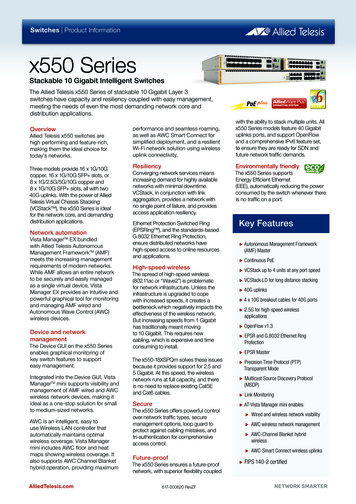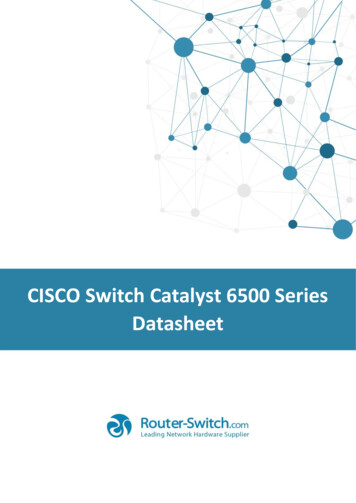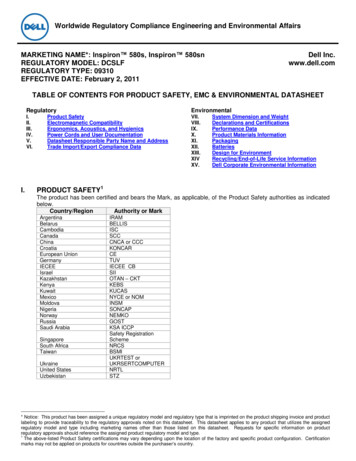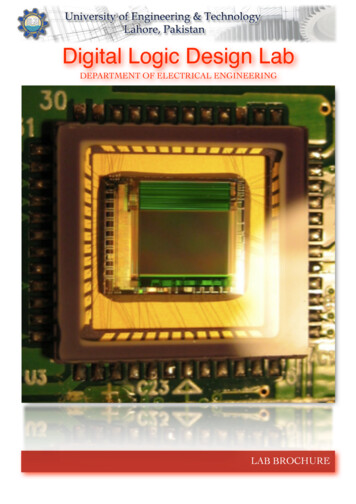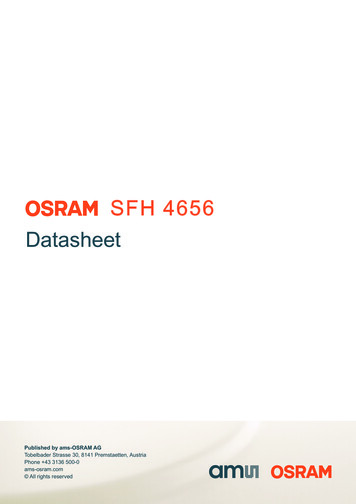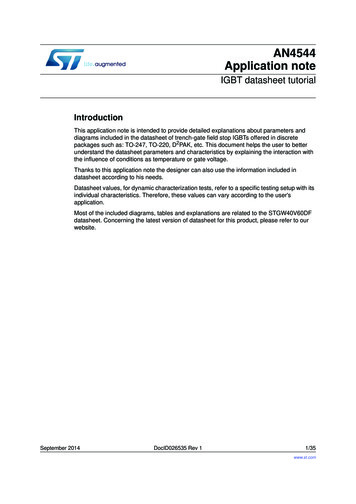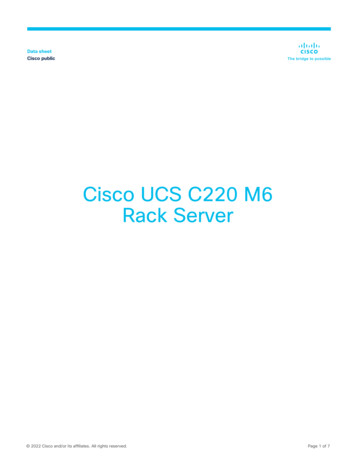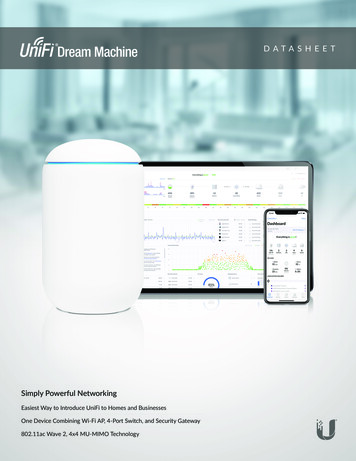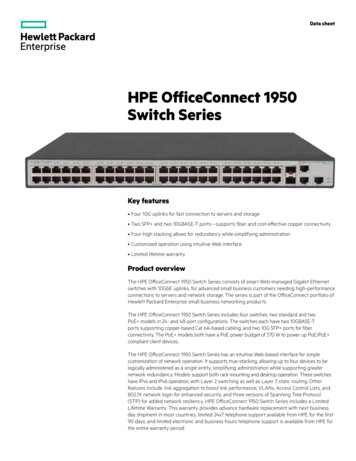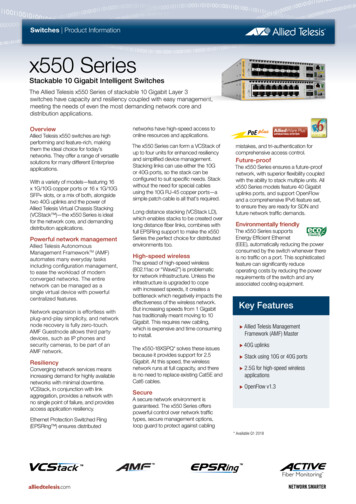
Transcription
Switches Product Informationx550 SeriesStackable 10 Gigabit Intelligent SwitchesThe Allied Telesis x550 Series of stackable 10 Gigabit Layer 3switches have capacity and resiliency coupled with easy management,meeting the needs of even the most demanding network core anddistribution applications.OverviewAllied Telesis x550 switches are highperforming and feature-rich, makingthem the ideal choice for today’snetworks. They offer a range of versatilesolutions for many different Enterpriseapplications.With a variety of models—featuring 16x 1G/10G copper ports or 16 x 1G/10GSFP slots, or a mix of both, alongsidetwo 40G uplinks and the power ofAllied Telesis Virtual Chassis Stacking(VCStack )—the x550 Series is idealfor the network core, and demandingdistribution applications.Powerful network managementAllied Telesis AutonomousManagement FrameworkTM (AMF)automates many everyday tasksincluding configuration management,to ease the workload of modernconverged networks. The entirenetwork can be managed as asingle virtual device with powerfulcentralized features.Network expansion is effortless withplug-and-play simplicity, and networknode recovery is fully zero-touch.AMF Guestnode allows third partydevices, such as IP phones andsecurity cameras, to be part of anAMF network.ResiliencyConverging network services meansincreasing demand for highly availablenetworks with minimal downtime.VCStack, in conjunction with linkaggregation, provides a network withno single point of failure, and providesaccess application resiliency.Ethernet Protection Switched Ring(EPSRing ) ensures distributednetworks have high-speed access toonline resources and applications.The x550 Series can form a VCStack ofup to four units for enhanced resiliencyand simplified device management.Stacking links can use either the 10Gor 40G ports, so the stack can beconfigured to suit specific needs. Stackwithout the need for special cablesusing the 10G RJ-45 copper ports—asimple patch cable is all that’s required.Long distance stacking (VCStack LD),which enables stacks to be created overlong distance fiber links, combines withfull EPSRing support to make the x550Series the perfect choice for distributedenvironments too.High-speed wirelessThe spread of high-speed wireless(802.11ac or “Wave2”) is problematicfor network infrastructure. Unless theinfrastructure is upgraded to copewith increased speeds, it creates abottleneck which negatively impacts theeffectiveness of the wireless network.But increasing speeds from 1 Gigabithas traditionally meant moving to 10Gigabit. This requires new cabling,which is expensive and time consumingto install.The x550-18XSPQ* solves these issuesbecause it provides support for 2.5Gigabit. At this speed, the wirelessnetwork runs at full capacity, and thereis no need to replace existing Cat5E andCat6 cables.Securemistakes, and tri-authentication forcomprehensive access control.Future-proofThe x550 Series ensures a future-proofnetwork, with superior flexibility coupledwith the ability to stack multiple units. Allx550 Series models feature 40 Gigabituplinks ports, and support OpenFlowand a comprehensive IPv6 feature set,to ensure they are ready for SDN andfuture network traffic demands.Environmentally friendlyThe x550 Series supportsEnergy Efficient Ethernet(EEE), automatically reducing the powerconsumed by the switch whenever thereis no traffic on a port. This sophisticatedfeature can significantly reduceoperating costs by reducing the powerrequirements of the switch and anyassociated cooling equipment.Key Features ۼۼ Allied Telesis ManagementFramework (AMF) Master ۼۼ 40G uplinks ۼۼ Stack using 10G or 40G ports ۼۼ 2.5G for high-speed wirelessapplications ۼۼ OpenFlow v1.3A secure network environment isguaranteed. The x550 Series offerspowerful control over network traffictypes, secure management options,loop guard to protect against cabling* Available Q1 2018alliedtelesis.comNETWORK SMARTER
x550 Series Stackable 10 Gigabit Intelligent SwitchesKey FeaturesAllied Telesis AutonomousManagement Framework (AMF) ۼۼ Allied Telesis Autonomous ManagementFramework (AMF) is a sophisticated suite ofmanagement tools that provide a simplifiedapproach to network management. Powerfulfeatures like centralized management, autobackup, auto-upgrade, auto-provisioning andauto-recovery enable plug-and-play networkingand zero-touch management. ۼۼ Any x550 Series switch can operate as theAMF network master, storing firmware andconfiguration backups for other network nodes.The AMF master enables auto-provisioning andauto-upgrade by providing appropriate files tonew network members. New network devicescan be pre-provisioned making installation easybecause no on-site configuration is required. ۼۼ AMF Guestnode allows Allied Telesis wirelessaccess points and further switching products, aswell as third party devices such as IP phones andsecurity cameras, to be part of an AMF network.Virtual Chassis Stacking (VCStack) ۼۼ Create a VCStack of up to four units with160 Gbps of stacking bandwidth to each unit.Stacking links are connected in a ring so eachdevice has dual connections to further improveresiliency. VCStack provides a highly availablesystem where network resources are spread outacross stacked units, reducing the impact if oneof the units fails. Aggregating switch ports ondifferent units across the stack provides excellentnetwork resiliency.Long-Distance Stacking(VCStack-LD) ۼۼ Long-distance stacking allows a VCStack tobe created over longer distances, perfect for adistributed network environment.Ethernet Protection Switched Ring(EPSRing) ۼۼ EPSRing and 10 Gigabit Ethernet allow severalx550 switches to form high-speed protected ringscapable of recovery within as little as 50ms. Thisfeature is perfect for high performance and highavailability in enterprise networks. ۼۼ Super-Loop Protection (SLP) enables a linkbetween two EPSR nodes to be in separate EPSRdomains, improving redundancy and network faultresiliency.Industry-leading Quality of Service(QoS) ۼۼ Comprehensive low-latency wire speed QoSprovides flow-based traffic management withfull classification, prioritization, traffic shapingand min/max bandwidth profiles. Boostednetwork performance and guaranteed deliveryof business-critical Ethernet services andapplications are provided. Time-critical services2 x550 Seriessuch as voice and video take precedence overnon-essential services such as file downloads,maintaining responsiveness of Enterpriseapplications.Loop Protection ۼۼ Thrash limiting, also known as rapid MACmovement, detects and resolves network loops.It is highly user-configurable — from the rateof looping traffic to the type of action the switchshould take when it detects a loop. ۼۼ With thrash limiting, the switch only detects a loopwhen a storm has occurred, which can potentiallycause disruption to the network. To avoid this,loop detection works in conjunction with thrashlimiting to send special Loop Detection Frame(LDF) packets that the switch listens for. If aport receives an LDF packet, you can chooseto disable the port, disable the link, or send anSNMP trap. This feature can help to detect loopsbefore a network storm occurs, avoiding the riskand inconvenience of traffic disruption.Power over Ethernet Plus (PoE ) ۼۼ With PoE, a separate power connection to mediaendpoints such as IP phones and wireless accesspoints is not necessary. PoE reduces costsand provides even greater flexibility, providingthe capability to connect devices requiring morepower (up to 30 Watts) such as pan, tilt and zoomsecurity cameras.Voice VLAN ۼۼ Voice VLAN automatically separates voiceand data traffic into two different VLANs. Thisautomatic separation places delay-sensitive trafficinto a voice- dedicated VLAN, which simplifiesQoS configurations.Open Shortest Path First (OSPFv3) ۼۼ OSPF is a scalable and adaptive routing protocolfor IP networks. The addition of OSPFv3 addssupport for IPv6 and further strengthens the AlliedTelesis focus on next generation networking.sFlow ۼۼ sFlow is an industry-standard technology formonitoring high-speed switched networks. Itprovides complete visibility into network use,enabling performance optimization, usageaccounting/billing, and defense against securitythreats. Sampled packets sent to a collector ensureit always has a real-time view of network traffic.VLAN Mirroring (RSPAN) ۼۼ VLAN mirroring allows traffic from a port on aremote switch to be analyzed locally. Traffic beingtransmitted or received on the port is duplicatedand sent across the network on a special VLAN.Optical DDM ۼۼ Most modern optical SFP/SFP /XFPtransceivers support Digital DiagnosticsMonitoring (DDM) functions according to thespecification SFF-8472. This enables realtime monitoring of the various parameters ofthe transceiver, such as optical output power,temperature, laser bias current and transceiversupply voltage. Easy access to this informationsimplifies diagnosing problems with opticalmodules and fiber connections.Active Fiber Monitoring ۼۼ Active Fiber Monitoring prevents eavesdroppingon fiber communications by monitoring receivedoptical power. If an intrusion is detected, thelink can be automatically shut down, or anoperator alert can be sent.Tri-authentication ۼۼ Authentication options on the x550 Series alsoinclude alternatives to IEEE 802.1x port-basedauthentication, such as web authentication, toenable guest access and MAC authenticationfor endpoints that do not have an IEEE 802.1xsupplicant. All three authentication methods—IEEE 802.1x, MAC-based and Web-based—can be enabled simultaneously on the sameport for tri-authentication.TACACS Command Authorization ۼۼ Centralize control of which commands maybe issued by a specific user of an AlliedWarePlus device. TACACS command authorizationcomplements authentication and accountingservices for a complete AAA solutionPremium Software License ۼۼ By default, the x550 Series offers acomprehensive Layer 2 and basic Layer 3feature set that includes static routing and IPv6management features. The feature set caneasily be elevated to full Layer 3 by applying thepremium software license. This adds dynamicrouting protocols and Layer 3 multicastingcapabilities.VLAN ACLs ۼۼ Simplify access and traffic control across entiresegments of the network. Access Control Lists(ACLs) can be applied to a Virtual LAN (VLAN)as well as a specific port.Software Defined Networking (SDN) ۼۼ OpenFlow is a key technology that enables theuse of SDN to build smart applications thatunlock value and reduce cost.
x550 Series Stackable 10 Gigabit Intelligent SwitchesKey 10x550 50x5 x530x250 50x5 x5ServerFarmNetworkAttachedSorage30x2VCStack link10 Gigabit link1 Gigabit link10/100 linkLink aggregationResilient distribution switchingAllied Telesis x550 Series switches are ideal fordistribution solutions, where resiliency and flexibility arerequired. In the above diagram, distribution switchesutilize long-distance Virtual Chassis Stacking (VCStackLD) to create a single virtual unit out of multiple devices.By using fiber stacking connectivity, units can bekilometers apart—perfect for a distributed environment.NETWORK SMARTERWhen combined with link aggregation, VCStack providesa solution with no single point of failure, and which fullyutilizes all available network bandwidth.x550 switches provide a resilient and reliable distributionsolution to support all networks with business-critical onlineresources and applications.x550 Series 3
x550 Series Stackable 10 Gigabit Intelligent SwitchesKey SolutionsServersEducation NetworkInternetMaster50 50x5 x5L10x510x5PX0M90GSStaff andstudent devicesResilient network corex550 switches have the power of Virtual ChassisStacking (VCStack), which removes any single point offailure from the network—making them perfect for smallbusiness or education solutions.The diagram shows a pair of x550 switches in aneducation environment, with link aggregation betweenthe core VCStack and servers, the firewall, and edgeswitches to provide resilient connectivity.4 x550 Series10 Gigabit link1 Gigabit linkWAN linkLink aggregationAllied Telesis edge switches connect and power accesspoints for wireless network connectivity for staff andstudents, as well as IP security cameras to ensure a safelearning environment.Allied Telesis Management Framework (AMF) simplifies andautomates many day to day administration tasks, easingthe burden of network management. The x550 switchesact as the AMF master, automatically backing up the entirenetwork, and providing plug-and-play network growth andzero-touch unit replacement.
x550 Series Stackable 10 Gigabit Intelligent SwitchesSpecifications1G/10G (RJ-45)COPPER PORTS1G/2.5G/10G (RJ-45)COPPER /10GSFP PORTS40G QSFP PORTSMAX POE ENABLED PORTSSWITCHINGFABRICFORWARDING 80Gbps357.1Mpps* Available Q1 2018Performance ۼۼ 160Gbps of stacking bandwidth ۼۼ Supports 13KB jumbo frames ۼۼ Wirespeed multicasting ۼۼ 4094 configurable VLANs ۼۼ Up to 16K MAC addresses ۼۼ 1024MB DDR SDRAM, 1024MB flash memory ۼۼ Packet buffer memory: 4MBReliability ۼۼ Modular AlliedWare PlusTM operating system ۼۼ Full environmental monitoring of PSUs, fans,temperature and internal voltages. SNMP trapsalert network managers in case of any failurePower Characteristics ۼۼ AC voltage: 90 to 260V (auto-ranging) ۼۼ Frequency: 47 to 63HzExpandability ۼۼ Stack up to four units in a VCStack ۼۼ Premium license option for additional featuresFlexibility and Compatibility ۼۼ 10G SFP ports will support any combination ofAllied Telesis 1000Mbps SFP and 10GbE SFP modules and direct attach cables listed in thisdocument under Ordering Information ۼۼ Stacking ports can be configured from 10G or40G ports ۼۼ Port speed and duplex configuration can be setmanually or by auto-negotiationDiagnostic Tools ۼۼ Active Fiber Monitoring detects tampering onoptical links ۼۼ Built-In Self Test (BIST) ۼۼ Cable fault locator (TDR) ۼۼ Find-me device locator ۼۼ Automatic link flap detection and port shutdown ۼۼ Optical Digital Diagnostic Monitoring (DDM) ۼۼ Ping polling for IPv4 and IPv6 ۼۼ Port mirroring ۼۼ TraceRoute for IPv4 and IPv6 ۼۼ Uni-Directional Link Detection (UDLD)IPv4 Features ۼۼ Black hole routing ۼۼ Directed broadcast forwarding ۼۼ DNS relay ۼۼ Equal Cost Multi Path (ECMP) routing ۼۼ Policy-based routing ۼۼ Route redistribution (OSPF, RIP) ۼۼ Static unicast and multicast routing for IPv4 ۼۼ UDP broadcast helper (IP helper)NETWORK SMARTERIPv6 Features ۼۼ DHCPv6 client and relay ۼۼ DNSv6 client and relay ۼۼ IPv4 and IPv6 dual stack ۼۼ IPv6 aware storm protection and QoS ۼۼ IPv6 hardware ACLs ۼۼ Device management over IPv6 networks withSNMPv6, Telnetv6 and SSHv6 ۼۼ NTPv6 client and server ۼۼ Static unicast and multicast routing for IPv6 ۼۼ Log to IPv6 hosts with Syslog v6Management ۼۼ Front panel 7-segment LED provides at-a-glancestatus and fault information ۼۼ Allied Telesis Management Framework (AMF)enables powerful centralized management andzero-touch device installation and recovery ۼۼ Console management port on the front panel forease of access ۼۼ Eco-friendly mode allows ports and LEDs to bedisabled to save power ۼۼ Web-based Graphical User Interface (GUI) ۼۼ Industry-standard CLI with context-sensitive help ۼۼ Powerful CLI scripting engine ۼۼ Comprehensive SNMP MIB support for standardsbased device management ۼۼ Built-in text editor ۼۼ Event-based triggers allow user-defined scripts tobe executed upon selected system events ۼۼ USB interface allows software release files,configurations and other files to be stored forbackup and distribution to other devicesQuality of Service ۼۼ 8 priority queues with a hierarchy of high priorityqueues for real time traffic, and mixed scheduling,for each switch port ۼۼ Limit bandwidth per port or per traffic class downto 64kbps ۼۼ Wirespeed traffic classification with low latencyessential for VoIP and real-time streaming mediaapplications ۼۼ IPv6 QoS support ۼۼ Policy-based QoS based on VLAN, port, MAC andgeneral packet classifiers ۼۼ Policy-based storm protection ۼۼ Extensive remarking capabilities ۼۼ Taildrop for queue congestion control ۼۼ Queue scheduling options for strict priority,weighted round robin or mixed scheduling ۼۼ Type of Service (ToS) IP precedence and DiffServmarking based on layer 2, 3 and 4 headersResiliency Features ۼۼ Control Plane Prioritization (CPP) ensures the CPUalways has sufficient bandwidth to process networkcontrol traffic ۼۼ Dynamic link failover (host attach) ۼۼ EPSRing (Ethernet Protection Switched Rings) withSuperLoop Protection (SLP) and enhanced recoveryfor extra resiliency ۼۼ Flexi-stacking - use any port speed to stack: 10Gfiber, 10G copper or 40G fiber ۼۼ Long-Distance VCStack over fiber with 10G SFP modules or 40G QSFP modules (LD-VCStack) ۼۼ Loop protection: loop detection and thrash limiting ۼۼ PVST compatibility mode ۼۼ STP root guard ۼۼ VCStack fast failover minimizes network disruptionSecurity Features ۼۼ Access Control Lists (ACLs) based on layer 3 and4 headers ۼۼ Auth fail and guest VLANs ۼۼ Authentication, Authorisation and Accounting(AAA) ۼۼ Bootloader can be password protected for devicesecurity ۼۼ BPDU protection ۼۼ DHCP snooping, IP source guard and DynamicARP Inspection (DAI) ۼۼ DoS attack blocking and virus throttling ۼۼ Dynamic VLAN assignment ۼۼ MAC address filtering and MAC address lockdown ۼۼ Network Access and Control (NAC) featuresmanage endpoint security ۼۼ Port-based learn limits (intrusion detection) ۼۼ Private VLANs provide security and port isolationfor multiple customers using the same VLAN ۼۼ Secure Copy (SCP) ۼۼ Secure File Transfer Protocol (SFTP) client ۼۼ Strong password security and encryption ۼۼ Tri-authentication: MAC-based, web-based andIEEE 802.1x ۼۼ Web-based authenticationSoftware Defined Networking ۼۼ OpenFlow v1.3 including support for connectioninterruption, control plane encryption andinactivity probeEnvironmental Specifications ۼۼ Operating temperature range:0 C to 45 C (32 F to 113 F)Derated by 1 C per 305 meters (1,000 ft) ۼۼ Storage temperature range:-25 C to 70 C (-13 F to 158 F) ۼۼ Operating relative humidity range:5% to 90% non-condensing ۼۼ Storage relative humidity range:5% to 95% non-condensing ۼۼ Operating altitude:3,048 meters maximum (10,000 ft)x550 Series 5
x550 Series Stackable 10 Gigabit Intelligent SwitchesElectrical Approvals andCompliances ۼۼ EMC: EN55022 class A, FCC class A, VCCI classA, ICES-003 class A ۼۼ Immunity: EN55024, EN61000-3-levels 2(Harmonics), and 3 (Flicker) – AC models onlyRestrictions on HazardousSubstances (RoHS) Compliance ۼۼ EU RoHS compliant ۼۼ China RoHS compliantSafety ۼۼ Standards: UL60950-1, CAN/CSA-C22.2 No.60950-1-03, EN60950-1, EN60825-1, AS/NZS60950.1 ۼۼ Certification: UL, cUL, TUVCountry of Origin ۼۼ ChinaPhysical SpecificationsPRODUCTWEIGHTWIDTHDEPTHHEIGHT210 mm (8.27 in)346 mm (13.62 in)42.5 mm (1.67 in)x550-18XSQ210 mm (8.27 in)346 mm (13.62 in)42.5 mm (1.67 in)x550-18XSPQAvailable Q1 2018x550-18XTQUNPACKAGEDPACKAGEDPower Characteristics90-260VAC auto ranging, 47-63HzNO POE LOADPRODUCTNOISEMAX HEATDISSIPATIONNOISEMAX POEPOWERMAX POE PORTSAT 30W PER PORT436 BTU/h50 dBA-----378 BTU/h46 dBA-----MAX ble Q1 2018x550-18XTQFULL POE LOADMAX POWERCONSUMPTIONMAX POWERCONSUMPTIONLatency (Microseconds)PORT 0-18XSQ3.9µs3.0µs2.2µsx550-18XSPQAvailable Q1 2018x550-18XTQStandards and ProtocolsVersion 5.4.7-1Non FIPS Approved AlgorithmsRNG Ware Plus Operating SystemRFC 1321RFC 1828MD5 Message-Digest algorithmIP authentication using keyed MD5Cryptographic AlgorithmsFIPS Approved AlgorithmsEncryption (Block Ciphers): ۼۼ AES (ECB, CBC, CFB and OFB Modes) ۼۼ 3DES (ECB, CBC, CFB and OFB Modes)Block Cipher Modes: ۼۼ CCM, CMAC, GCM, XTSDigital Signatures & Asymmetric Key Generation: ۼۼ DSA, ECDSA, RSASecure Hashing: ۼۼ SHA-1 ۼۼ SHA-2 (SHA-224, SHA-256, SHA-384. SHA-512)Message Authentication: ۼۼ HMAC (SHA-1, SHA-2(224, 256, 384, 512)Random Number Generation: ۼۼ DRBG (Hash, HMAC and Counter)6 x550 SeriesIEEE 802.2 Logical Link Control (LLC)IEEE 802.3 EthernetIEEE 802.3ab1000BASE-TIEEE 802.3ae 10 Gigabit EthernetIEEE 802.3an 10GBASE-TIEEE 802.3az Energy Efficient Ethernet (EEE)IEEE 802.3ba 40GBASE-XIEEE 802.3x Flow control - full-duplex operationIEEE 802.3z 1000BASE-XIPv4 FeaturesRFCRFCRFCRFCRFCRFC768791792793826894RFC 919RFC 922RFC 932User Datagram Protocol (UDP)Internet Protocol (IP)Internet Control Message Protocol (ICMP)Transmission Control Protocol (TCP)Address Resolution Protocol (ARP)Standard for the transmission of IPdatagrams over Ethernet networksBroadcasting Internet datagramsBroadcasting Internet datagrams in thepresence of subnetsSubnetwork addressing schemeRFC 950RFC 951RFC 1027RFC 1035RFC 1042RFC 1071RFC 1122RFC 1191RFC 1256RFC 1518RFC 1519RFC 1542RFC 1591RFC 1812RFC 1918RFC 2581Internet standard subnetting procedureBootstrap Protocol (BootP)Proxy ARPDNS clientStandard for the transmission of IPdatagrams over IEEE 802 networksComputing the Internet checksumInternet host requirementsPath MTU discoveryICMP router discovery messagesAn architecture for IP address allocation withCIDRClassless Inter-Domain Routing (CIDR)Clarifications and extensions for BootPDomain Name System (DNS)Requirements for IPv4 routersIP addressingTCP congestion controlIPv6 FeaturesRFC 1981RFC 2460RFC 2464RFC 3484RFC 3587RFC 3596RFC 4007RFC 4193Path MTU discovery for IPv6IPv6 specificationTransmission of IPv6 packets over EthernetnetworksDefault address selection for IPv6IPv6 global unicast address formatDNS extensions to support IPv6IPv6 scoped address architectureUnique local IPv6 unicast addresses
x550 Series Stackable 10 Gigabit Intelligent SwitchesRFC 4213RFC 4291RFC 4443RFC 4861RFC 4862RFC 5014RFC 5095RFC 5175RFC 6105Transition mechanisms for IPv6 hosts androutersIPv6 addressing architectureInternet Control Message Protocol (ICMPv6)Neighbor discovery for IPv6IPv6 Stateless Address Auto-Configuration(SLAAC)IPv6 socket API for source address selectionDeprecation of type 0 routing headers in IPv6IPv6 Router Advertisement (RA) flags optionIPv6 Router Advertisement (RA) guardManagementAMF MIB and SNMP trapsAT Enterprise MIBSNMPv1, v2c and v3IEEE 802.1ABLink Layer Discovery Protocol (LLDP)RFC 1155 Structure and identification of managementinformation for TCP/IP-based InternetsRFC 1157 Simple Network Management Protocol(SNMP)RFC 1212 Concise MIB definitionsRFC 1213 MIB for network management of TCP/IP-based Internets: MIB-IIRFC 1215 Convention for defining traps for use with theSNMPRFC 1227 SNMP MUX protocol and MIBRFC 1239 Standard MIBRFC 1724 RIPv2 MIB extensionRFC 2578 Structure of Management Information v2(SMIv2)RFC 2579 Textual conventions for SMIv2RFC 2580 Conformance statements for SMIv2RFC 2674 Definitions of managed objects for bridgeswith traffic classes, multicast filtering andVLAN extensionsRFC 2741 Agent extensibility (AgentX) protocolRFC 2787 Definitions of managed objects for VRRPRFC 2819 RMON MIB (groups 1,2,3 and 9)RFC 2863 Interfaces group MIBRFC 3164 Syslog protocolRFC 3176 sFlow: a method for monitoring traffic inswitched and routed networksRFC 3411 An architecture for describing SNMPmanagement frameworksRFC 3412 Message processing and dispatching for theSNMPRFC 3413 SNMP applicationsRFC 3414 User-based Security Model (USM) forSNMPv3RFC 3415 View-based Access Control Model (VACM)for SNMPRFC 3416 Version 2 of the protocol operations for theSNMPRFC 3417 Transport mappings for the SNMPRFC 3418 MIB for SNMPRFC 3635 Definitions of managed objects for theEthernet-like interface typesRFC 3636 IEEE 802.3 MAU MIBRFC 4022 MIB for the Transmission Control Protocol(TCP)RFC 4113 MIB for the User Datagram Protocol (UDP)RFC 4188 Definitions of managed objects for bridgesRFC 4292 IP forwarding table MIBRFC 4293 MIB for the Internet Protocol (IP)RFC 4318 Definitions of managed objects for bridgeswith RSTPRFC 4560 Definitions of managed objects for remoteping, traceroute and lookup operationsRFC 6527 Definitions of managed objects for VRRPv3NETWORK SMARTERMulticast SupportBootstrap Router (BSR) mechanism for PIM-SMIGMP query solicitationIGMP snooping (IGMPv1, v2 and v3)IGMP snooping fast-leaveIGMP/MLD multicast forwarding (IGMP/MLD proxy)MLD snooping (MLDv1 and v2)PIM for IPv6 and PIM SSM for IPv6RFC 1112 Host extensions for IP multicasting (IGMPv1)RFC 2236 Internet Group Management Protocol v2(IGMPv2)RFC 2710 Multicast Listener Discovery (MLD) for IPv6RFC 2715 Interoperability rules for multicast routingprotocolsRFC 3306 Unicast-prefix-based IPv6 multicastaddressesRFC 3376 IGMPv3RFC 3810 Multicast Listener Discovery v2 (MLDv2) forIPv6RFC 3956 Embedding the Rendezvous Point (RP)address in an IPv6 multicast addressRFC 3973 PIM Dense Mode (DM)RFC 4541 IGMP and MLD snooping switchesRFC 4601 Protocol Independent Multicast - SparseMode (PIM-SM): protocol specification(revised)RFC 4604 Using IGMPv3 and MLDv2 for source-specific multicastRFC 4607 Source-specific multicast for IPSecurity FeaturesSSH remote loginSSLv2 and SSLv3TACACS Accounting, Authentication, Authorization (AAA)IEEE 802.1X authentication protocols (TLS, TTLS, PEAPand MD5)IEEE 802.1X multi-supplicant authenticationIEEE 802.1X port-based network access controlRFC 2818 HTTP over TLS (“HTTPS”)RFC 2865 RADIUS authenticationRFC 2866 RADIUS accountingRFC 2868 RADIUS attributes for tunnel protocol supportRFC 3280 Internet X.509 PKI Certificate and CertificateRevocation List (CRL) profileRFC 3546 Transport Layer Security (TLS) extensionsRFC 3579 RADIUS support for ExtensibleAuthentication Protocol (EAP)RFC 3580 IEEE 802.1x RADIUS usage guidelinesRFC 3748 PPP Extensible Authentication Protocol (EAP)RFC 4251 Secure Shell (SSHv2) protocol architectureRFC 4252 Secure Shell (SSHv2) authentication protocolRFC 4253 Secure Shell (SSHv2) transport layer protocolRFC 4254 Secure Shell (SSHv2) connection protocolRFC 5246 TLS v1.2ServicesOSPF link-local signalingOSPF MD5 authenticationOut-of-band LSDB resyncRFC 1245 OSPF protocol analysisRFC 1246 Experience with the OSPF protocolRFC 1370 Applicability statement for OSPFRFC 1765 OSPF database overflowRFC 2328 OSPFv2RFC 2370 OSPF opaque LSA optionRFC 2740 OSPFv3 for IPv6RFC 3101 OSPF Not-So-Stubby Area (NSSA) optionRFC 3509 Alternative implementations of OSPF areaborder routersRFC 3623 Graceful OSPF restartRFC 3630 Traffic engineering extensions to OSPFRFC 4552 Authentication/confidentiality for OSPFv3RFC 5329 Traffic engineering extensions to OSPFv3\RFC 5340 OSPFv3 for IPv6 (partial support)RFC 854Telnet protocol specificationRFC 855Telnet option specificationsRFC 857Telnet echo optionRFC 858Telnet suppress go ahead optionRFC 1091 Telnet terminal-type optionRFC 1350 Trivial File Transfer Protocol (TFTP)RFC 1985SMTP service extensionRFC 2049 MIMERFC 2131 DHCPv4 (server, relay and client)RFC 2132 DHCP options and BootP vendor extensionsRFC 2616 Hypertext Transfer Protocol - HTTP/1.1RFC 2821 Simple Mail Transfer Protocol (SMTP)RFC 2822 Internet message formatRFC 3046 DHCP relay agent information option (DHCPoption 82)RFC 3315 DHCPv6 (server, relay and client)RFC 3633 IPv6 prefix options for DHCPv6RFC 3646 DNS configuration options for DHCPv6RFC 3993 Subscriber-ID suboption for DHCP relayagent optionRFC 4330 Simple Network Time Protocol (SNTP)version 4RFC 5905 Network Time Protocol (NTP) version 4Quality of Service (QoS)VLAN SupportOpen Shortest Path First (OSPF)IEEE 802.1p Priority taggingRFC 2211 Specification of the controlled-load networkelement serviceRFC 2474 DiffServ precedence for eight queues/portRFC 2475 DiffServ architectureRFC 2597 DiffServ Assured Forwarding (AF)RFC 2697 A single-rate three-color markerRFC 2698 A two-rate three-color markerRFC 3246 DiffServ Expedited Forwarding (EF)Generic VLAN Registration Protocol (GVRP)IEEE 802.1ad Provider bridges (VLAN stacking, Q-in-Q)IEEE 802.1Q Virtual LAN (VLAN) bridgesIEEE 802.1v VLAN classification by protocol and portIEEE 802.3ac VLAN taggingVoice over IP (VoIP)LLDP-MED ANSI/TIA-1057Voice VLANResiliency FeaturesIEEE 802.1AXLink aggregation (static and LACP)IEEE 802.1D MAC bridgesIEEE 802.1s Multiple Spanning Tree Protocol (MSTP)IEEE 802.1w Rapid Spanning Tree Protocol (RSTP)IEEE 802.3ad Static and dynamic link aggregationRFC 5798 Virtual Router Redundancy Protocol version 3(VRRPv3) for IPv4 and IPv6x550 Series 7
x550 Series Stackable 10 Gigabit Intelligent SwitchesOrdering Information40GbE QSPF ModulesFeature LicensesNAMEDESCRIPTIONINCLUDESSTACK LICENSINGAT-FL-x550-01x550 premium license ۼۼ RIP (256 routes) ۼۼ OSPF (256 routes) ۼۼ PIMv4-SM, DM and SSM ۼۼ EPSR master ۼۼ VLAN double tagging (Q-in-Q) ۼۼ RIPng (256 routes) ۼۼ OSPFv3 (256 routes) ۼۼ MLDv1 and v2 ۼۼ PIMv6-SM ۼۼ UDLD ۼۼ One license per stackmemberAT-QSFPLR440GLR4 1310 nm medium-haul, 10 km with SMFAT-QSFPSR440GSR4 850 nm short-haul up to 150 m withMMFAT-QSFP1CUQSFP copper cable 1mAT-QSFP3CUQSFP copper cable 3mAT-FL-x550-AM20-1YRAMF Master license ۼۼ AMF Master 20 nodes for 1 year ۼۼ One license per stack10GbE SFP ModulesAT-FL-x550-AM20-5YRAMF Master license ۼۼ AMF Master 20 nodes for 5 years ۼۼ One license per stackAT-FL-x550-OF13-1YROpenFlow license ۼۼ OpenFlow v1.3 for 1 year ۼۼ Not supportedAT-SP10SR10GSR 850 nm short-haul, 300 m with MMFAT-FL-x550-OF13-5YROpenFlow license ۼۼ OpenFlow v1.3 for 5 years ۼۼ Not supportedSwitches1000Mbps SFP ModulesAT-x550-18XTQ-xx16-port 1G/10G BaseT stackable switch with2 QSFP portsAT-SPTXa1000T 100 m copperAT-x550-18XSQ-xx*16-port 1G/10G SFP stackable switch with2 QSFP portsAT-x550-18XSPQ-xx**8-port 1G/2.5G/10G BaseT PoE and 8-port1G/10G SFP stackable switch with2 QSFP portsAT-SPSX1000SX GbE multi-mode 850
network can be managed as a single virtual device with powerful centralized features. Network expansion is effortless with plug-and-play simplicity, and network node recovery is fully zero-touch. AMF Guestnode allows third party devices, such as IP phones and security cameras, to be part of an AMF network. Resiliency Converging network services .
